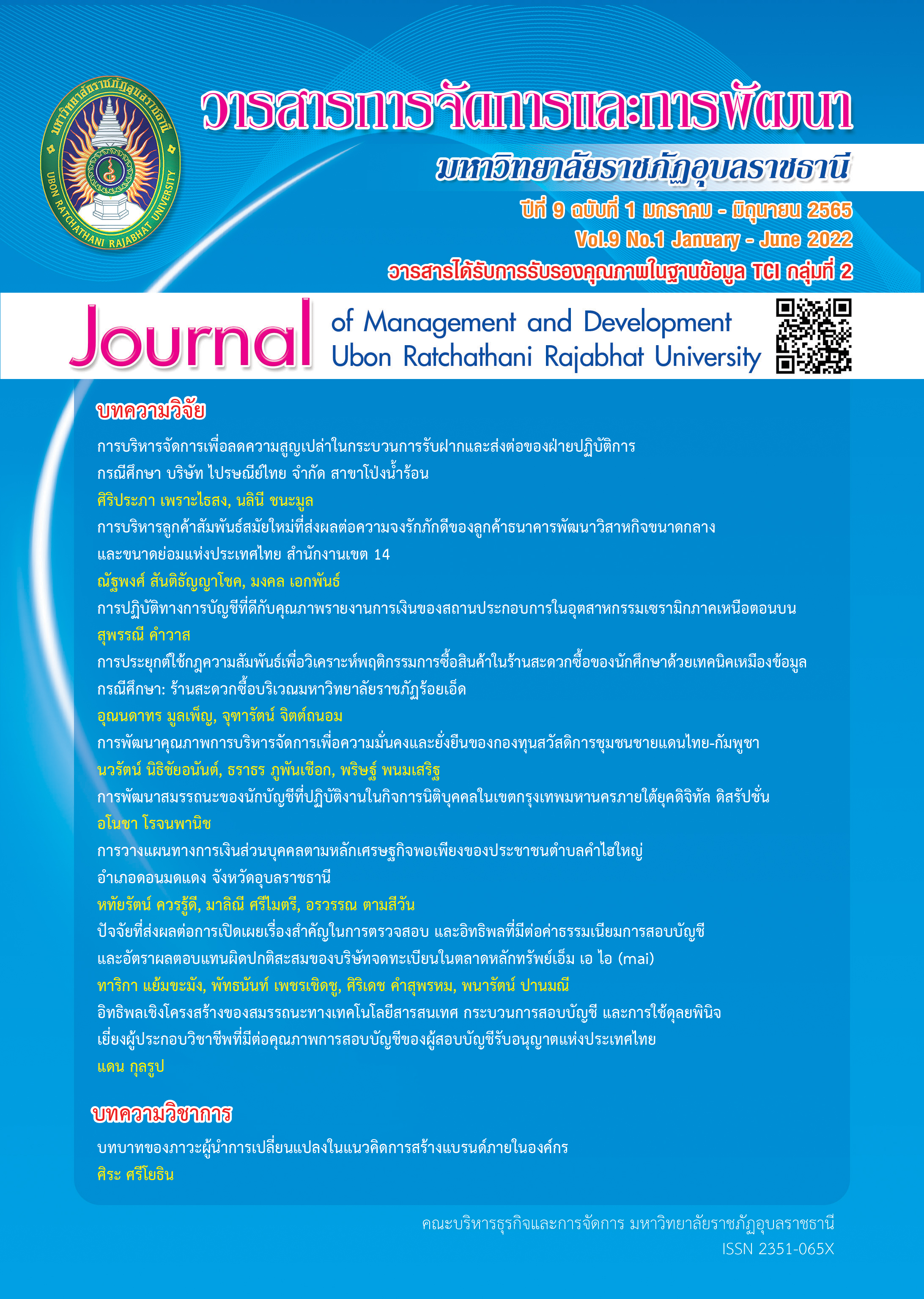ปัจจัยที่ส่งผลต่อการเปิดเผยเรื่องสำคัญในการตรวจสอบ และอิทธิพลที่มีต่อ ค่าธรรมเนียมการสอบบัญชีและอัตราผลตอบแทนผิดปกติสะสมของ บริษัทจดทะเบียนในตลาดหลักทรัพย์เอ็ม เอ ไอ (mai)
คำสำคัญ:
การเปิดเผยเรื่องสำคัญในการตรวจสอบ, ค่าธรรมเนียมการสอบบัญชี, อัตราผลตอบแทนผิดปกติสะสม, บริษัทจดทะเบียนในตลาดหลักทรัพย์เอ็ม เอ ไอบทคัดย่อ
งานวิจัยครั้งนี้มีวัตถุประสงค์เพื่อ 1) ศึกษาปัจจัยที่ส่งผลต่อการเปิดเผยเรื่องสำคัญในการตรวจสอบ และอิทธิพลของเรื่องสำคัญในการตรวจสอบที่มีต่อค่าธรรมเนียมการสอบบัญชีและอัตราผลตอบแทนผิดปกติสะสม
2) ศึกษาประเภทสำนักงานบัญชีที่มีอิทธิพลต่อค่าธรรมเนียมการสอบบัญชีผ่านการเปิดเผยเรื่องสำคัญในการตรวจสอบ ด้วยวิจัยเชิงปริมาณเก็บข้อมูลจากงบการเงินประจำปีของบริษัทจดทะเบียนในตลาดหลักทรัพย์
เอ็ม เอ ไอ กลุ่มตัวอย่างตั้งแต่ปี พ.ศ. 2559 ถึง พ.ศ. 2561 ข้อมูลดังกล่าววิเคราะห์สมการโครงสร้าง (Structural Equation Model: SEM) โดยการวิเคราะห์เส้นทาง (Path Analysis) ผลการวิจัยพบว่า การลงทุนในบริษัทย่อยไม่มีอิทธิพลต่อการเปิดเผยเรื่องสำคัญในการตรวจสอบ ประเภทสำนักงานสอบบัญชีมีอิทธิพลทางตรงต่อการเปิดเผยเรื่องสำคัญในการตรวจสอบ และการเปิดเผยเรื่องสำคัญในการตรวจสอบมีอิทธิพลทางตรงต่อค่าธรรมเนียมการสอบบัญชีและอัตราผลตอบแทนผิดปกติสะสม นอกจากนี้ผลการทดสอบยังพบว่าประเภทสำนักงานสอบบัญชีมีอิทธิพลทางอ้อมต่อค่าธรรมเนียมการสอบบัญชีผ่านการเปิดเผยเรื่องสำคัญในการตรวจสอบอย่างมีนัยสำคัญทางสถิติ ณ ระดับ .05 ผลวิจัยดังกล่าวแสดงให้เห็นว่าการเปลี่ยนแปลงหน้ารายงานผู้สอบบัญชีช่วยเพิ่มมูลค่าการสื่อสารให้กับผู้มีส่วนได้เสียมากขึ้น เช่น นักลงทุนมีปฏิกิริยาตอบสนองต่อตลาดในช่วงที่มีการประกาศรายงานผู้สอบบัญชีรับอนุญาตส่งผลให้นักลงทุนสามารถวางแผน และคาดการณ์แนวโน้มของผลตอบแทนได้อย่างเหมาะสม
เอกสารอ้างอิง
เกรียงไกร บุญเลิศอุทัย ศิลปพร ศรีจั่นเพชร และอนุวัฒน์ ภักดี. (2562). เรื่องสำคัญในการตรวจสอบบอกอะไร. วารสารวิชาชีพบัญชี, 15(45), 5-25.
ชาญชัย ตั้งเรือนรัตน์. (2558). คุณค่าของรายงานผู้สอบบัญชีแบบใหม่. วารสารวิชาชีพบัญชี, 11(32), 26 - 44.
ตลาดหลักทรัพย์แห่งประเทศไทย. (2560). งบการเงิน ปี 59 – ปี 61. สืบค้นเมื่อ 19 สิงหาคม 2562 จาก https://www.set.or.th/set/commonslookup.do?msg=nf&language=th&country.
Alexandris, G. Mavrovitis, Ch. F. & Travlos, N. (2012). How Have M&As Changed? Evidence from the Sixth Merger Wave. The European Journal of Finance, 18(8), 663-688.
Almulla, M. & Bradbury, M. E. (2018). Auditor, Client, and Investor Consequences of The Enhanced Auditor’s Report. Retrieved January 15, 2020, from https://www.researchgate.net
Asare, S. K. & Wright, A. M. (2012). Investors, Auditors, and Lenders Understanding of the Message Conveyed by the Standard Audit Report on the Financial Statements. Accounting horizons, 26(2), 193–217.
Bedard, J. et al. (2016). Does Recent Academic Research Support Changes to Audit Reporting Standards?. American Accounting Association, 30(2). 255 – 275.
Bedard, J. Gonthier-Besacier, N. & Schatt, A. (2018). Consequences of Justifications of Assessments in French Expanded Audit Reports. Retrieved January 15, 2020, from https://doi.org/10.2139/ssrn.3175497.
Brant, E. Christensen, S. M. & Christopher, J. W. (2014). Do Critical Audit Matter Paragraphs in
the Audit Report Change Nonprofessional Investors’ Decision to Invest?. American Accounting Association, 33(4), 71–93.
Burns, N. & Grove, S. K. (1993). Study The Practice of Nursing Research: Conduct, Critique & Utilization, (Forth edition). Retrieved January 15, 2020, from https://www.scirp.org /(S(vtj3fa45qm1ean45vvffcz55))/reference/ReferencesPapers.aspx?ReferenceID=
DeAngelo, L. E. (1981). Auditor Size and Audit Quality. Journal of Accounting and Economics, 3(3), 183-199.
Fama, E. F. (1970). Efficient Capital Markets: A Review of Theory and Empirical Work.
The Journal of Finance, 25(2), 383-417.
Ferreira, C. & Morais, A. I. (2020). Analysis of the Relationship between Company Characteristics and Key Audit Matters Disclosed. Revista Contabilidade & Finanças, 31(83), 262-274.
FMA & EXRB. (2017). Key Audit Matters: A Stock Take of The First Year in New Zeala. Retrieved January 15, 2020, from https://www.xrb.govt.nz/dmsdocument/2614.
Financial Reporting Council. (2015). Extended Auditor’s Reports: a Review of Experience
in The First Year. Retrieved January 15, 2020, from https://www.frc.org.uk/
getattachment/561627cc-facb-431b-beda-ead81948604e/Extended-Auditor-Reports-March-2015.pdf
International Auditing and Assurance Standards Board. (2011). Enhancing The Value of Auditor Reporting: Exploring Options for Change (Consultations Paper). Retrieved January 15, 2020, from https://www.ifac.org/system/files/publications/
exposuredrafts/CP_Auditor_Reporting- Final.pdf.
International Federation of Accountants. (2015). Auditor Reporting – Key Audit Matters. Retrieved January 15, 2020, from http://www.ifac.org/system/files/
publications/files/Auditor-Reporting-Toolkit- KAM-Overview.pdf.
Jensen, M. C. & Mecking, W. H. (1976). Theory of The Firm: Managerial Behavior, Agency Costs, and Capital Structure. Journal of Financial Economics, 4(3), 73-109.
Kitiwong, W. & Sarapaivanich, N. (2020). Consequences of The Implementation of Expanded Audit Reports with Key Audit Matters (KAMs) on Audit Quality. Managerial Auditing Journal, 35(8), 1095-1119.
Kistana, G. L. (2016). Factors Affecting Audit Fees in Private Commercial Banking Industries: In Ethiopia. Master of Science in Accounting and Auditing, Addis Ababa University.
KPMG International Cooperative. (2017). Key Audit Matters: Auditor’s Report Snapshot 20 September 2017. Retrieved January 15, 2020, from https://assets.kpmg.com /content/dam/kpmg/au/pdf/2017 /key-audit-matters-auditor-report-20-september-2017.pdf.
Lawrence, A. Miguel, M. M. & Ping, Z. (2011). Can Big 4 Versus Non-Big 4 Differences in Audit-Quality Proxies Be Attributed to Client Characteristics?. The Accounting Review, 86(1). 259–286.
MacKinley, C. (1997). Event Studies in Economics and Finance, Journal of Economic Literature, 35(1), 13-39.
Ozcan, A. (2021). What Factors Affect the Disclosure of Key Audit Matters? Evidence from Manufacturing Firms. International Journal of Management Economics and Business, 17(12), 149 – 161.
Pinto, I. & Morais, A. I. (2019). What Matters in Disclosures of Key Audit Matters: Evidence from Europe. Journal of International Financial Management & Accounting, 30(2), 145-162.
Sirois, L. P. Bédard, J. & Bera, P. (2017). The Informational Value of Key Audit Matters in The Auditor's Report: Evidence from An Eye-ธracking Study. Accounting Horizons, 32(2), 141-162.
Suttipun, M. (2020). Factors Influencing Key Audit Matters Reporting in Thailand. Asian Journal of Accounting Perspectives, 13(1), 26-39.
Sorokina, N. Booth, D. E. & Thornton, Jr. J. H. (2013). Robust Methods in Event Studies: Empirical Evidence and Theoretical Implications. Journal of Data Science, 11(3),
-606.
Steenkamp, N. & Northcott, D. (2007). Content Analysis in Accounting Research: The Practical Challenges. Australian Accounting Review, 17(43), 12-25.
Thompson, A. M. Schmidt, J. J. & Lennox, C. S. (2016). Is The Expanded Model of Audit Reporting Informative to Investors: Evidence from The UK. Retrieved January 15, 2020, from https://papers.ssrn.com/sol3/papers.cfm?abstract_id=2619785.

ดาวน์โหลด
เผยแพร่แล้ว
ฉบับ
ประเภทบทความ
สัญญาอนุญาต

อนุญาตภายใต้เงื่อนไข Creative Commons Attribution-NonCommercial-NoDerivatives 4.0 International License.
บทความที่ตีพิมพ์ในวารสาร เป็นงานเขียนของนักวิจัยหรือนักวิชาการแต่ละท่านโดยเฉพาะ มิใช่ความเห็นและความรับผิดชอบใดๆ ของกองบรรณาธิการวารสารการจัดการและการพัฒนา มหาวิทยาลัยราชภัฏอุบลราชธานี
บทความ ข้อมูล เนื้อหา รูปภาพ ฯลฯ ที่ได้รับการตีพิมพ์ในวารสารฯ ถือเป็นลิขสิทธิ์ของวารสารการจัดการและการพัฒนา มหาวิทยาลัยราชภัฏอุบลราชธานี หากบุคคลหรือหน่วยงานใดต้องการนำทั้งหมดหรือส่วนหนึ่งส่วนใดไปเผยแพร่ต่อหรือเพื่อกระทำการใดๆ จะต้องทำการอ้างอิงมายังวารสาร




